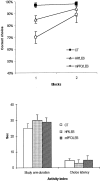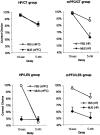Time-dependent relationship between the dorsal hippocampus and the prefrontal cortex in spatial memory
- PMID: 12598640
- PMCID: PMC6742248
- DOI: 10.1523/JNEUROSCI.23-04-01517.2003
Time-dependent relationship between the dorsal hippocampus and the prefrontal cortex in spatial memory
Abstract
The prefrontal cortex and the dorsal hippocampus have been studied extensively for their significant roles in spatial working memory. A possible time-dependent functional relationship between the prefrontal cortex and the dorsal hippocampus in spatial working memory was tested. A combined lesion and pharmacological inactivation technique targeting both the dorsal hippocampus and the medial prefrontal cortex was used (i.e., axon-sparing lesions of the dorsal hippocampus combined with reversible inactivation of the medial prefrontal cortex, or vice versa, within a subject). A delayed nonmatching-to-place task on a radial eight-arm maze with short-term (i.e., 10 sec) versus intermediate-term (i.e., 5 min) delays was used as a behavioral paradigm. Here we report that the dorsal hippocampus and the medial prefrontal cortex process short-term spatial memory in parallel, serving as a compensatory mechanism for each other. The role of the dorsal hippocampus, however, becomes highlighted as the time-window for memory (i.e., delay) shifts from short-term to a delay period (i.e., intermediate-term) exceeding the short-term range. The results indicate that the time window of memory is a key factor in dissociating multiple memory systems.
Figures




Similar articles
-
Ventral Midline Thalamus Is Critical for Hippocampal-Prefrontal Synchrony and Spatial Working Memory.J Neurosci. 2016 Aug 10;36(32):8372-89. doi: 10.1523/JNEUROSCI.0991-16.2016. J Neurosci. 2016. PMID: 27511010 Free PMC article.
-
Specific role of the posterior dorsal hippocampus-prefrontal cortex in short-term working memory.Eur J Neurosci. 2008 Jun;27(11):3029-34. doi: 10.1111/j.1460-9568.2008.06284.x. Epub 2008 Jun 6. Eur J Neurosci. 2008. PMID: 18540879
-
Systemic and local administration of estradiol into the prefrontal cortex or hippocampus differentially alters working memory.Neurobiol Learn Mem. 2006 Nov;86(3):293-304. doi: 10.1016/j.nlm.2006.04.003. Epub 2006 May 26. Neurobiol Learn Mem. 2006. PMID: 16730465
-
[Hippocampal-prefrontal cortical circuit and working memory].Dongwuxue Yanjiu. 2010 Feb;31(1):50-6. doi: 10.3724/sp.j.1141.2010.01050. Dongwuxue Yanjiu. 2010. PMID: 20446454 Review. Chinese.
-
Working memory for visual objects: complementary roles of inferior temporal, medial temporal, and prefrontal cortex.Neuroscience. 2006 Apr 28;139(1):277-89. doi: 10.1016/j.neuroscience.2005.06.092. Epub 2005 Dec 15. Neuroscience. 2006. PMID: 16343785 Review.
Cited by
-
Impaired spatial memory performance in a rat model of neuropathic pain is associated with reduced hippocampus-prefrontal cortex connectivity.J Neurosci. 2013 Feb 6;33(6):2465-80. doi: 10.1523/JNEUROSCI.5197-12.2013. J Neurosci. 2013. PMID: 23392675 Free PMC article.
-
Using synchronized brain rhythms to bias memory-guided decisions.Elife. 2024 Jul 22;12:RP92033. doi: 10.7554/eLife.92033. Elife. 2024. PMID: 39037771 Free PMC article.
-
Time Cells in the Hippocampus Are Neither Dependent on Medial Entorhinal Cortex Inputs nor Necessary for Spatial Working Memory.Neuron. 2019 Jun 19;102(6):1235-1248.e5. doi: 10.1016/j.neuron.2019.04.005. Epub 2019 May 2. Neuron. 2019. PMID: 31056352 Free PMC article.
-
Distribution of Alox15 in the Rat Brain and Its Role in Prefrontal Cortical Resolvin D1 Formation and Spatial Working Memory.Mol Neurobiol. 2018 Feb;55(2):1537-1550. doi: 10.1007/s12035-017-0413-x. Epub 2017 Feb 8. Mol Neurobiol. 2018. PMID: 28181190 Free PMC article.
-
Hippocampal interictal epileptiform activity disrupts cognition in humans.Neurology. 2013 Jul 2;81(1):18-24. doi: 10.1212/WNL.0b013e318297ee50. Epub 2013 May 17. Neurology. 2013. PMID: 23685931 Free PMC article.
References
-
- Clark RE, West AN, Zola SM, Squire LR. Rats with lesions of the hippocampus are impaired on the delayed nonmatching-to-sample task. Hippocampus. 2001;11:176–186. - PubMed
-
- Constantinidis C, Franowicz MN, Goldman-Rakic PS. The sensory nature of mnemonic representation in the primate prefrontal cortex. Nat Neurosci. 2001;4:311–316. - PubMed
-
- Delatour B, Gisquet-Verrier P. Prelimbic cortex specific lesions disrupt delayed-variable response tasks in the rat. Behav Neurosci. 1996;110:1282–1298. - PubMed
-
- Dias R, Aggleton JP. Effects of selective excitotoxic prefrontal lesions on acquisition of nonmatching- and matching-to-place in the T-maze in the rat: differential involvement of the prelimbic-infralimbic and anterior cingulated cortices in providing behavioural flexibility. Eur J Neurosci. 2000;12:4457–4466. - PubMed
Publication types
MeSH terms
Substances
LinkOut - more resources
Full Text Sources
Other Literature Sources
Medical
